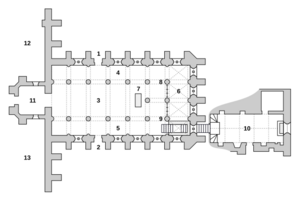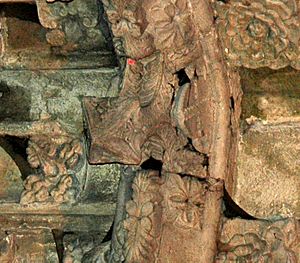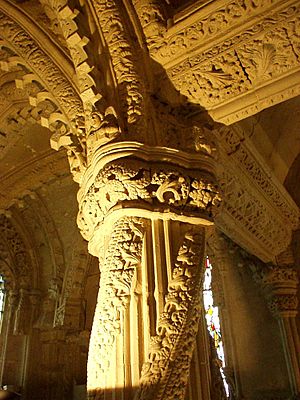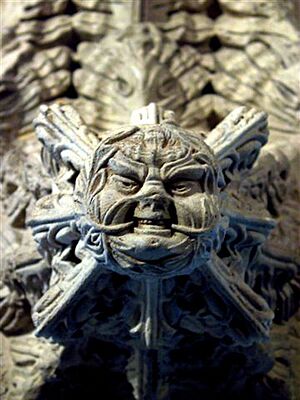Rosslyn Chapel facts for kids
Quick facts for kids Rosslyn Chapel |
|
|---|---|
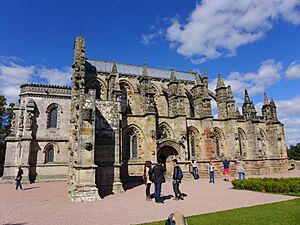
Rosslyn Chapel, August 2014
|
|
| 55°51′19″N 3°09′37″W / 55.85528°N 3.16028°W | |
| OS grid reference | NT275630 |
| Location | Roslin, Midlothian |
| Country | Scotland |
| Denomination | Scottish Episcopal Church |
| Previous denomination | Roman Catholic |
| History | |
| Status | Chapel |
| Dedication | Saint Matthew |
| Architecture | |
| Functional status | Active |
| Heritage designation | Category A |
| Groundbreaking | 20 September 1456 |
| Administration | |
| Diocese | Edinburgh |
Rosslyn Chapel, also known as the Collegiate Chapel of Saint Matthew, is a beautiful 15th-century chapel in the village of Roslin in Midlothian, Scotland. It belongs to the Scottish Episcopal Church. The chapel was started in 1456 by William Sinclair, 1st Earl of Caithness.
After the Scottish Reformation in 1560, the chapel was mostly left empty. However, after Queen Victoria visited in 1842, it was restored and reopened in 1862. In 1914, it was damaged by a bomb during a campaign for women's right to vote.
The chapel's inside is famous for its amazing carvings. Many people have tried to understand what these carvings mean. Since the late 1980s, some people have suggested that the chapel is connected to the Knights Templar or the Holy Grail. These ideas became very popular after the book The Da Vinci Code by Dan Brown and its movie version came out. However, historians say there is no real proof for these stories. Rosslyn Chapel is still owned privately today.
Contents
History of Rosslyn Chapel
Building the Chapel
Rosslyn Chapel is dedicated to Saint Matthew the Evangelist. It was built on a small hill above Roslin Glen. It was meant to be a collegiate church, which means it had a group of priests and boy singers. William Sinclair, 1st Earl of Caithness, from the Sinclair family, started building it in the mid-1400s.
Rosslyn Chapel is the third church built by the Sinclair family in Roslin. The first was inside Roslin Castle. The second was in what is now Roslin Cemetery. William Sinclair wanted the chapel to be a place where prayers and Catholic Masses were held day and night. He also wanted prayers for his family members who had passed away. He set up money to pay for the priests and singers forever.
Changes Over Time
In 1560, the Scottish Reformation happened, which changed how churches were run in Scotland. Catholic worship in the chapel stopped, and its altars were destroyed in 1592.
For many years, the chapel was in ruins and overgrown. But in 1842, Queen Victoria visited and wanted it to be saved. Restoration work began in 1862, led by David Bryce. The chapel was rededicated on April 22, 1862. From then on, Sunday services started again, now as part of the Scottish Episcopal Church.
The 1914 Bombing
On July 11, 1914, a bomb exploded inside Rosslyn Chapel. This was part of a campaign by suffragettes, who were women fighting for the right to vote. Between 1912 and 1914, suffragettes carried out many attacks to protest. Churches were often targets because some believed the Church of England was against women's suffrage. Many churches were attacked across the country during this time.
Saving and Sharing the Chapel
The Rosslyn Chapel Trust was created in 1995. Its job is to take care of the chapel and make it a place for visitors. From 1997 to 2013, the chapel went through a big restoration project. This included fixing the roof, stone, carvings, and stained-glass windows. A large steel cover was placed over the roof for 14 years to protect it from rain and help it dry out.
A new visitor center opened in July 2011. The chapel's stained-glass windows and organ were fully repaired. New lighting and heating were also put in. The restoration cost around £13 million. Money came from different groups, including the Heritage Lottery Fund. The actor Tom Hanks also gave a donation.
Since 2008, taking photos or videos inside the chapel has not been allowed. The chapel sells professional photos in its shop. In 2013–14, Rosslyn Chapel had over 144,000 visitors. The current owner is Peter St Clair-Erskine, 7th Earl of Rosslyn.
Chapel Architecture
We don't have the original plans for Rosslyn Chapel, so we don't know exactly how it was meant to look. But its architecture is considered some of the best in Scotland. Building started on September 20, 1456.
The chapel was planned to be shaped like a cross, but only the choir section was finished. The Lady Chapel was built on top of a much older crypt, which might have been part of an earlier castle. The foundations for the parts that were never built were found in the 1800s.
The chapel stands on 14 pillars. These pillars form arches around the main area. At the east end, three special pillars stand out: the Master Pillar, the Journeyman Pillar, and the famous Apprentice Pillar.
The Apprentice Pillar
The "Apprentice Pillar" is one of the most famous parts of the chapel. It was originally called the "Prince's Pillar." Its name changed over time because of a legend from the 1700s.
The story says that the master stonemason in charge of the chapel's carvings didn't think his young apprentice could carve such a complex column. The master mason traveled to see the original design for inspiration. But when he came back, he found that the apprentice had already finished the column perfectly! In a fit of anger and jealousy, the master mason hit the apprentice on the head with his mallet, killing him. The legend ends by saying that the master mason's face was carved into a corner of the chapel. He is forever looking at the Apprentice Pillar as punishment.
On the stone arch above the pillar, there is an inscription that says: "Wine is strong, a king is stronger, women are stronger still, but truth conquers all."
A full-size copy of the Apprentice Pillar was made in 1871. You can see it in the Victoria and Albert Museum in London.
Amazing Carvings
Rosslyn Chapel has many detailed carvings. There are 213 small cubes or "boxes" sticking out from the pillars and arches. Each has a different pattern. No one knows for sure what these patterns mean. Many people have tried to find a hidden message in them, but there's no clear answer yet. Sadly, many of these boxes are not original. They were replaced in the 1800s because of damage.
One idea is that the patterns on the boxes are a musical score. Some patterns look like "Chladni patterns," which are shapes made by vibrating powder on a surface. By matching these patterns to musical notes, a father-and-son team, Thomas and Stuart Mitchell, created a tune they call the Rosslyn Motet.
You can find more than 110 carvings of "Green Men" inside and outside the chapel. Green Men are human faces surrounded by plants, often with plants growing out of their mouths. They are found all over the chapel.
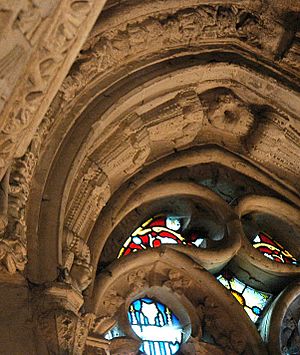
Other carvings show plants like wheat, strawberries, or lilies. Some authors, Robert Lomas and Christopher Knight, have suggested that some carvings look like ears of corn (maize). Corn was not known in Europe when the chapel was built. However, a botanist named Adrian Dyer thought that the "corn" and "aloe" carvings were just decorative patterns that happened to look like real plants.
The Crypt
Rosslyn Chapel has been a burial place for many generations of the Sinclair family. There is a crypt that was once reached by stairs at the back of the chapel. This crypt has been sealed shut for many years. This is why there are many legends about it. Some stories say it hides the mummified head of Jesus Christ, the Holy Grail, the Knights Templar's treasure, or even the original crown jewels of Scotland.
In 1837, when the 2nd Earl of Rosslyn passed away, he wanted to be buried in the original vault. People searched for a week, but they couldn't find the entrance to the original vault. So, he was buried next to his wife in the Lady Chapel.
Rooftop Discoveries
During renovation work in 2010, workers found something interesting in the pinnacles (tall, pointed parts) on the rooftop. Jackdaws (birds) had made the pinnacles unstable. When they were taken apart, brick by brick, a hidden chamber was found. This chamber was specially made by the stonemasons to hold bees! The beehive was empty, but it was sent to local beekeepers to study.
Burials at Rosslyn Chapel
Many members of the Sinclair family and other important people have been buried at Rosslyn Chapel over the centuries. Some notable burials include:
- William Sinclair, 1st Earl of Caithness (in the choir)
- James St Clair-Erskine, 2nd Earl of Rosslyn (in the Lady Chapel)
- James St Clair-Erskine, 3rd Earl of Rosslyn
- Anthony St Clair-Erskine, 6th Earl of Rosslyn
See also
 In Spanish: Capilla Rosslyn para niños
In Spanish: Capilla Rosslyn para niños
- Castle of Mey
- Clan Sinclair
- Earl of Caithness
- List of Category A listed buildings in Midlothian
- Sinclair (surname)
- Sinclair & Girnigoe Castle
- Roslin Castle



